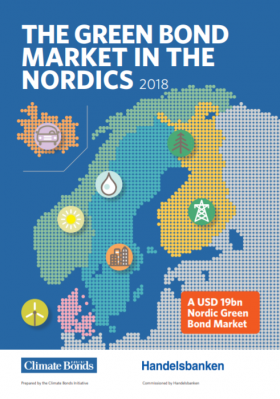The Climate Bonds Initiative just published their first report examining the Nordic green bond market. It covers Denmark, Finland, Iceland, Norway and Sweden, and was commissioned by Handelsbanken.
The report provides an overview of the region’s green bond market and sets out our analysis by issuer type, financed sectors and countries. The report also identifies Nordic issuers of vanilla bonds in industry sectors conducive to green bond issuance and seeks to outline potential avenues to future market growth and development.
Download the full report here.
Nordic countries lead by example
The Nordic countries have evolved in the context of the Nordic Model, which is based on decentralisation and cooperation across countries and municipalities to enhance the effectiveness of service delivery. Against this background, the region was able to position itself at the forefront of integrating environmental and sustainability targets within budgets at a central and local government level.
The Nordic Investment Bank (NIB), a supranational, and Norwegian state bank KBN Kommunalkredit were among the very first to start issuing green bonds, both debuting in 2010.
Several important green bond firsts have come from the region: the first green city bond (City of Gothenburg), the first corporate green bond and the first green bond from a real estate company (Vasakronan), and first labelled Green MTN corporate bond programme (Fabege), to name a few.
Gothenburg and Vasakronen were amongst the organisations recognised at our inaugural Green Bond Pioneer Awards in 2016.
Nordic stock exchanges have also contributed to the green bond market’s development. Oslo Bors and Nasdaq Stockholm were the first stock exchanges to introduce dedicated green / sustainable bond segments in 2015.
The region is a leader in the use of external reviews, a contribution to promoting market integrity and best practice at a global scale. Over 98% of outstanding green bonds benefit from a Second Party Opinion (SPO), with the only exception being NIB bonds issued prior to Q3 2014.
More recently, in October 2017, ten Nordic public sector issuers published a Position Paper on Green Bond Impact Reporting. The guide seeks to harmonise the approach to impact reporting to enhance market transparency.
Report Highlights:
- Despite their relatively small size, Nordic nations rank highly on a global scale, with Sweden at 6th, Norway 16th, Denmark 17th and Finland 20th place by cumulative issuance.
- The Nordic Investment Bank (NIB) is the region’s largest issuer to date.
- Nordic nations including supranational NIB, account for 6.7% of global cumulative green bond issue volume and 18.5% of European issuance.
- Annual issuance broke a new record in 2017 at EUR7.8bn, 64% up from 2016 and 10.5 times higher than the 2013 total.
- Fifteen new green bond issuers entered the market in 2017.
- Corporate issuance was boosted by large deals from Danish energy company Orsted and three commercial banks – Nordea, SEB and Swedbank.
- Swedish property company Atrium Ljungberg, a newcomer to the market became a repeat issuer during the year.
Download the full report here.
February 2018
